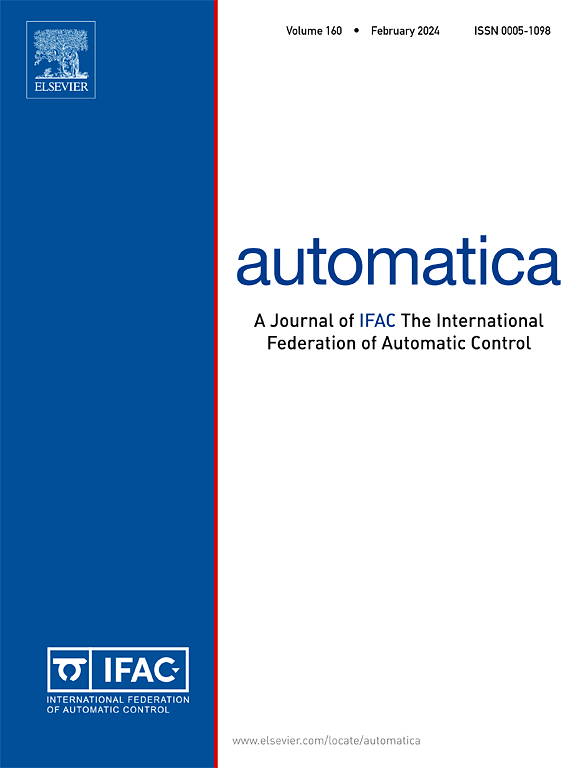The identification of parameter in a finite set under one-bit quantized observations
IF 4.8
2区 计算机科学
Q1 AUTOMATION & CONTROL SYSTEMS
引用次数: 0
Abstract
This paper studies the identification of finite impulse response models whose parameters belong to a finite set under only one-bit quantized observations. Distinct from traditional parameter identification, the target parameter in some practical tasks belongs to a known finite set, rather than a continuous interval. Although the prior set of the parameter carries more information, the identification problem becomes more complicated due to it transforming into a discrete optimization problem, and existing identification methods based on continuous optimization cannot be used directly. To overcome this difficulty, an empirical measures based discrete projection algorithm is proposed. The algorithm first constructs a parameter estimation in a continuous set that includes the prior parameter set, and then maps the estimation to the known discrete set. The proposed algorithm is proved to be convergent in the almost sure sense, and to achieve an exponential convergence rate in the mean square sense under some mild conditions. Compared to the Cramér–Rao lower bound where the unknown parameter resides in a continuous interval, the conclusions reveal a significant improvement in parameter identification performance. Finally, simulations are presented to demonstrate the feasibility of the proposed algorithm.
位量化观测下有限集合参数的辨识
研究了在单比特量化观测条件下,参数属于有限集的有限脉冲响应模型的辨识问题。与传统的参数辨识不同,在一些实际任务中,目标参数属于一个已知的有限集合,而不是一个连续区间。虽然参数的先验集携带了更多的信息,但由于其转化为离散优化问题,使得辨识问题变得更加复杂,现有的基于连续优化的辨识方法无法直接使用。为了克服这一困难,提出了一种基于经验测度的离散投影算法。该算法首先在包含先验参数集的连续集合中构造参数估计,然后将估计映射到已知的离散集合。证明了该算法在几乎确定意义上是收敛的,在一些温和条件下均方意义上达到指数收敛速率。与未知参数驻留在连续区间的cram r - rao下界相比,结论显示参数识别性能有显著提高。最后,通过仿真验证了该算法的可行性。
本文章由计算机程序翻译,如有差异,请以英文原文为准。
求助全文
约1分钟内获得全文
求助全文
来源期刊

Automatica
工程技术-工程:电子与电气
CiteScore
10.70
自引率
7.80%
发文量
617
审稿时长
5 months
期刊介绍:
Automatica is a leading archival publication in the field of systems and control. The field encompasses today a broad set of areas and topics, and is thriving not only within itself but also in terms of its impact on other fields, such as communications, computers, biology, energy and economics. Since its inception in 1963, Automatica has kept abreast with the evolution of the field over the years, and has emerged as a leading publication driving the trends in the field.
After being founded in 1963, Automatica became a journal of the International Federation of Automatic Control (IFAC) in 1969. It features a characteristic blend of theoretical and applied papers of archival, lasting value, reporting cutting edge research results by authors across the globe. It features articles in distinct categories, including regular, brief and survey papers, technical communiqués, correspondence items, as well as reviews on published books of interest to the readership. It occasionally publishes special issues on emerging new topics or established mature topics of interest to a broad audience.
Automatica solicits original high-quality contributions in all the categories listed above, and in all areas of systems and control interpreted in a broad sense and evolving constantly. They may be submitted directly to a subject editor or to the Editor-in-Chief if not sure about the subject area. Editorial procedures in place assure careful, fair, and prompt handling of all submitted articles. Accepted papers appear in the journal in the shortest time feasible given production time constraints.
 求助内容:
求助内容: 应助结果提醒方式:
应助结果提醒方式:


